|
|

|
|
Author
|
Topic: NASA Mars probes and Comet Siding Spring flyby
|
Robert Pearlman
Editor Posts: 42988
From: Houston, TX
Registered: Nov 1999
|
 posted 07-25-2014 02:46 PM
posted 07-25-2014 02:46 PM
   
NASA release NASA Mars spacecraft prepare for close comet flybyNASA is taking steps to protect its Mars orbiters, while preserving opportunities to gather valuable scientific data, as Comet C/2013 A1 Siding Spring heads toward a close flyby of Mars on Oct. 19. The comet's nucleus will miss Mars by about 82,000 miles (132,000 kilometers), shedding material hurtling at about 35 miles (56 kilometers) per second, relative to Mars and Mars-orbiting spacecraft. At that velocity, even the smallest particle — estimated to be about one-fiftieth of an inch (half a millimeter) across — could cause significant damage to a spacecraft. 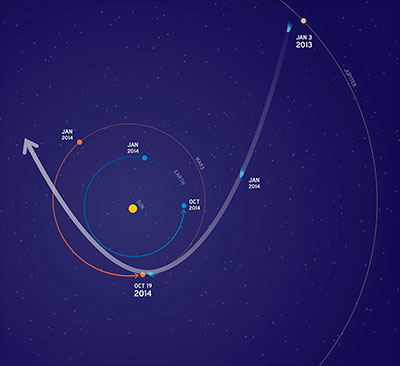 Above: This graphic depicts the orbit of comet C/2013 A1 Siding Spring as it swings around the sun in 2014. NASA currently operates two Mars orbiters, with a third on its way and expected to arrive in Martian orbit just a month before the comet flyby. Teams operating the orbiters plan to have all spacecraft positioned on the opposite side of the Red Planet when the comet is most likely to pass by. "Three expert teams have modeled this comet for NASA and provided forecasts for its flyby of Mars," explained Rich Zurek, chief scientist for the Mars Exploration Program at NASA's Jet Propulsion Laboratory in Pasadena, California. "The hazard is not an impact of the comet nucleus, but the trail of debris coming from it. Using constraints provided by Earth-based observations, the modeling results indicate that the hazard is not as great as first anticipated. Mars will be right at the edge of the debris cloud, so it might encounter some of the particles — or it might not." During the day's events, the smallest distance between Siding Spring's nucleus and Mars will be less than one-tenth the distance of any known previous Earthly comet flyby. The period of greatest risk to orbiting spacecraft will start about 90 minutes later and last about 20 minutes, when Mars will come closest to the center of the widening dust trail from the nucleus. NASA's Mars Reconnaissance Orbiter (MRO) made one orbit-adjustment maneuver on July 2 as part of the process of repositioning the spacecraft for the Oct. 19 event. An additional maneuver is planned for Aug. 27. The team operating NASA's Mars Odyssey orbiter is planning a similar maneuver on Aug. 5 to put that spacecraft on track to be in the right place at the right time, as well. NASA's Mars Atmosphere and Volatile Evolution (MAVEN) spacecraft is on its way to the Red Planet and will enter orbit on Sept. 21. The MAVEN team is planning to conduct a precautionary maneuver on Oct. 9, prior to the start of the mission's main science phase in early November. In the days before and after the comet's flyby, NASA will study the comet by taking advantage of how close it comes to Mars. Researchers plan to use several instruments on the Mars orbiters to study the nucleus, the coma surrounding the nucleus, and the tail of Siding Spring, as well as the possible effects on the Martian atmosphere. This particular comet has never before entered the inner solar system, so it will provide a fresh source of clues to our solar system's earliest days. MAVEN will study gases coming off the comet's nucleus into its coma as it is warmed by the sun. MAVEN also will look for effects the comet flyby may have on the planet's upper atmosphere and observe the comet as it travels through the solar wind. Odyssey will study thermal and spectral properties of the comet's coma and tail. MRO will monitor Mars' atmosphere for possible temperature increases and cloud formation, as well as changes in electron density at high altitudes. The MRO team also plans to study gases in the comet's coma. Along with other MRO observations, the team anticipates this event will yield detailed views of the comet's nucleus and potentially reveal its rotation rate and surface features. Mars' atmosphere, though much thinner than Earth's, is thick enough that NASA does not anticipate any hazard to the Opportunity and Curiosity rovers on the planet's surface, even if dust particles from the comet hit the atmosphere and form into meteors. Rover cameras may be used to observe the comet before the flyby, and to monitor the atmosphere for meteors while the comet's dust trail is closest to the planet. Observations from Earth-based and space telescopes provided data used for modeling to make predictions about Siding Spring's Mars flyby, which were in turn used for planning protective maneuvers. The three modeling teams were headed by researchers at the University of Maryland in College Park, the Planetary Science Institute in Tucson, Arizona, and JPL. |
Philip
Member Posts: 5952
From: Brussels, Belgium
Registered: Jan 2001
|
 posted 09-24-2014 10:41 AM
posted 09-24-2014 10:41 AM
   
On 19th October, comet 2013 A1 will pass close by Mars.Curious to see what the spacecraft orbiting and the rovers on the surface of the planet will be able to see of this comet passing close by Mars. Never in human history was such a close flyby (not impact) of a comet witnessed... Last year in March I had the privilege to visit astronomer and ace comet hunter Robert McNaught at the Siding Spring observatory in Australia and we talked about his discoveries and follow-on observations.  |
Robert Pearlman
Editor Posts: 42988
From: Houston, TX
Registered: Nov 1999
|
 posted 10-09-2014 02:23 PM
posted 10-09-2014 02:23 PM
   
NASA release NASA Prepares its Science Fleet for Oct. 19 Mars Comet EncounterNASA's extensive fleet of science assets, particularly those orbiting and roving Mars, have front row seats to image and study a once-in-a-lifetime comet flyby on Sunday, Oct. 19. Comet C/2013 A1, also known as comet Siding Spring, will pass within about 87,000 miles (139,500 kilometers) of the Red Planet -- less than half the distance between Earth and our moon and less than one-tenth the distance of any known comet flyby of Earth. Siding Spring's nucleus will come closest to Mars around 2:27 p.m. EDT, hurtling at about 126,000 mph (56 kilometers per second). This proximity will provide an unprecedented opportunity for researchers to gather data on both the comet and its effect on the Martian atmosphere. 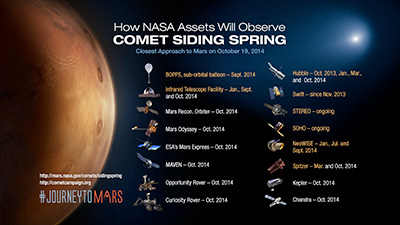 "This is a cosmic science gift that could potentially keep on giving, and the agency's diverse science missions will be in full receive mode," said John Grunsfeld, astronaut and associate administrator for NASA's Science Mission Directorate in Washington. "This particular comet has never before entered the inner solar system, so it will provide a fresh source of clues to our solar system's earliest days." Siding Spring came from the Oort Cloud, a spherical region of space surrounding our sun and occupying space at a distance between 5,000 and 100,000 astronomical units. It is a giant swarm of icy objects believed to be material left over from the formation of the solar system. Siding Spring will be the first comet from the Oort Cloud to be studied up close by spacecraft, giving scientists an invaluable opportunity to learn more about the materials, including water and carbon compounds, that existed during the formation of the solar system 4.6 billion years ago. Some of the best and most revealing images and science data will come from assets orbiting and roving the surface of Mars. In preparation for the comet flyby, NASA maneuvered its Mars Odyssey orbiter, Mars Reconnaissance Orbiter (MRO), and the newest member of the Mars fleet, Mars Atmosphere and Volatile EvolutioN (MAVEN), in order to reduce the risk of impact with high-velocity dust particles coming off the comet. The period of greatest risk to orbiting spacecraft will start about 90 minutes after the closest approach of the comet's nucleus and will last about 20 minutes, when Mars will come closest to the center of the widening trail of dust flying from the comet's nucleus. "The hazard is not an impact of the comet nucleus itself, but the trail of debris coming from it. Using constraints provided by Earth-based observations, the modeling results indicate that the hazard is not as great as first anticipated. Mars will be right at the edge of the debris cloud, so it might encounter some of the particles -- or it might not," said Rich Zurek, chief scientist for the Mars Exploration Program at NASA's Jet Propulsion Laboratory (JPL) in Pasadena, California. The atmosphere of Mars, though much thinner that Earth's, will shield NASA Mars rovers Opportunity and Curiosity from comet dust, if any reaches the planet. Both rovers are scheduled to make observations of the comet. NASA's Mars orbiters will gather information before, during and after the flyby about the size, rotation and activity of the comet's nucleus, the variability and gas composition of the coma around the nucleus, and the size and distribution of dust particles in the comet's tail. Observations of the Martian atmosphere are designed to check for possible meteor trails, changes in distribution of neutral and charged particles, and effects of the comet on air temperature and clouds. MAVEN will have a particularly good opportunity to study the comet, and how its tenuous atmosphere, or coma, interacts with Mars' upper atmosphere. Earth-based and space telescopes, including NASA's iconic Hubble Space Telescope, also will be in position to observe the unique celestial object. The agency's astrophysics space observatories -- Kepler, Swift, Spitzer, Chandra -- and the ground-based Infrared Telescope Facility on Mauna Kea, Hawaii -- also will be tracking the event. NASA's asteroid hunter, the Near-Earth Object Wide-field Infrared Survey Explorer (NEOWISE), has been imaging, and will continue to image, the comet as part of its operations. And the agency's two Heliophysics spacecraft, Solar TErrestrial RElations Observatory (STEREO) and Solar and Heliophysics Observatory (SOHO), also will image the comet. The agency's Balloon Observation Platform for Planetary Science (BOPPS), a sub-orbital balloon-carried telescope, already has provided observations of the comet in the lead-up to the close encounter with Mars. Images and updates will be posted online before and after the comet flyby. Several pre-flyby images of Siding Spring, as well as information about the comet and NASA's planned observations of the event, are available online. |
Cozmosis22
Member Posts: 968
From: Texas * Earth
Registered: Apr 2011
|
 posted 10-16-2014 11:09 PM
posted 10-16-2014 11:09 PM
  
Coming up in a couple of days.Am sure we are all hoping that they get a lot of good data and clean imagery of this once-in-a-lifetime galactic visitor. Some time ago there was speculation about Martian dust storms obscuring the rovers' view but no recent mention of it on the NASA website. |
Philip
Member Posts: 5952
From: Brussels, Belgium
Registered: Jan 2001
|
 posted 10-19-2014 06:53 AM
posted 10-19-2014 06:53 AM
   
ESA and NASA accounts on Twitter already show images of the planet and the comet together. At closest approach both objects will be just 1 arcminute 53 arcseconds apart... |
Blackarrow
Member Posts: 3120
From: Belfast, United Kingdom
Registered: Feb 2002
|
 posted 10-19-2014 12:11 PM
posted 10-19-2014 12:11 PM
  
Well, the comet encounter has happened. Any damage? Any pictures of the comet? |
Robert Pearlman
Editor Posts: 42988
From: Houston, TX
Registered: Nov 1999
|
 posted 10-19-2014 12:16 PM
posted 10-19-2014 12:16 PM
   
You're a bit early. Closest approach is at 2:27 p.m. EDT (1827 GMT). |
Robert Pearlman
Editor Posts: 42988
From: Houston, TX
Registered: Nov 1999
|
 posted 10-19-2014 05:09 PM
posted 10-19-2014 05:09 PM
   
ESA reports that Mars Express engineers have confirmed full contact established with the spacecraft after a planned loss of signal, but it will be next week before the results of its observations are known. |
Robert Pearlman
Editor Posts: 42988
From: Houston, TX
Registered: Nov 1999
|
 posted 10-19-2014 06:18 PM
posted 10-19-2014 06:18 PM
   
NASA release NASA's Mars Reconnaissance Orbiter Studies Comet FlybyNASA's Mars Reconnaissance Orbiter, which has sent home more data about Mars than all other missions combined, is also now providing data about a comet that buzzed The Red Planet today (Oct. 19). The orbiter continues operating in good health after sheltering behind Mars during the half hour when high-velocity dust particles from comet C/2013 A1 Siding Spring had the most chance of reaching the paths of Mars orbiters. It maintained radio communications with Earth throughout the comet's closest approach, at 11:27 a.m. PDT (2:27 p.m. EDT), and the peak dust-risk period centered about 100 minutes later. "The spacecraft performed flawlessly throughout the comet flyby," said Mars Reconnaissance Orbiter Project Manager Dan Johnston of NASA's Jet Propulsion Laboratory, Pasadena, California. "It maneuvered for the planned observations of the comet and emerged unscathed." Following the critical period of dust flux, the orbiter is communicating at 1.5 megabits per second with NASA's Deep Space Network. It remained on Side A of its two redundant computers, and all subsystems are working as expected. Downlink of data has begun from today's comet observations by three instruments on Mars Reconnaissance Orbiter. The full downlink may take days. These instruments -- the High Resolution Imaging Science Experiment (HiRISE), the Compact Imaging Spectrometer for Mars (CRISM), and the Context Camera (CTX) -- also observed the comet for days before the flyby and will continue to make observations of it in the next few days. The orbiter's other three instruments are being used to study possible effects of gas and dust in the comet's tail interacting with the atmosphere of Mars. These are the Mars Climate Sounder (MCS), the Mars Color Imager (MARCI) and the Mars Shallow Radar (SHARAD). Three NASA Mars orbiters, two Mars rovers and other assets on Earth and in space are studying comet Siding Spring. This comet is making its first visit this close to the sun from the outer solar system's Oort Cloud, so the concerted campaign of observations may yield fresh clues to our solar system's earliest days more than 4 billion years ago. Following the comet flyby, operators of NASA's Mars Atmosphere and Volatile EvolutioN (MAVEN) orbiter are assessing the status of that orbiter and operators for NASA's Mars Odyssey are anticipating resumption of communications. The Mars Reconnaissance Orbiter mission met all its science goals for the two-year primary science phase ending in 2008. The spacecraft's overtime work since then has added to the science returns. The mission has provided more than 240 trillion bits of data about Mars, a volume equivalent to three-and-a-half months of nonstop, high-definition video. The data it acquired during the comet's closest approach to Mars are now being transmitted to Earth, but it will take many hours before downlink is complete and processing can start. Objectives of the observing program are to attempt to image the comet nucleus, to study its surrounding coma of dust and gas, and to search for signatures of that material interacting with the Mars atmosphere. Observations of the comet will continue for another day or so, as the comet and Mars separate, with the comet reaching its closest approach to the sun in about a week, on Oct. 25. |
Robert Pearlman
Editor Posts: 42988
From: Houston, TX
Registered: Nov 1999
|
 posted 10-19-2014 07:09 PM
posted 10-19-2014 07:09 PM
   
NASA release NASA's MAVEN Studies Passing Comet and Its EffectsNASA's newest orbiter at Mars, MAVEN, took precautions to avoid harm from a dust-spewing comet that flew near Mars today and is studying the flyby's effects on the Red Planet's atmosphere. The MAVEN spacecraft -- full name Mars Atmosphere and Volatile Evolution -- reported back to Earth in good health after about three hours of precautions against a possible collision with high-velocity dust particles released by comet C/2013 A1 Siding Spring. "We're glad the spacecraft came through, we're excited to complete our observations of how the comet affects Mars, and we're eager to get to our primary science phase," said MAVEN Principal Investigator Bruce Jakosky of the University of Colorado, Boulder. MAVEN began orbiting Mars on Sept. 21. The opportunity to study this rare near-miss of a planet by a comet comes during the project's commissioning phase. A few weeks of instrument calibration and orbit fine-tuning remain before the start of the primary science phase. The mission will study the upper atmosphere of Mars and its interaction with the solar wind. Comet Siding Spring hurtled past Mars today at about 125,000 mph (56 kilometers per second), coming within about 87,000 miles (139,500 kilometers) of the planet. That is equivalent to about one-third of the distance between Earth and Earth's moon. The closest approach by the comet's nucleus came at about 11:27 a.m. PDT (2:27 p.m. EDT). The period when dust from the comet was most likely to reach Mars and the orbits of spacecraft around Mars peaked about 100 minutes later. From about 10:45 a.m. to 2 p.m. PDT (1:45 p.m. to 5:00 p.m. EDT) MAVEN kept in a defensive posture to reduce its profile relative to the direction from which the comet's high-velocity dust particles would come. In that "hunkered down" orientation, its main antenna was not facing the right way for transmitting to Earth, so communications were maintained at low data rate via a secondary antenna. Also, the mission performed a maneuver on Oct. 2 that set its orbit timing so that the spacecraft was behind Mars, relative to the possible dust flow, from about 12:53 p.m. to 1:23 p.m. PDT (3:53 p.m. to 4:23 p.m. EDT). Downlink of data has begun from MAVEN observations of the comet and Mars' atmosphere. Some observations are designed to provide information about the composition of the gases and dust being released by the comet. Others are investigating possible interaction between material from the comet and the atmosphere of Mars. Three NASA Mars orbiters, two Mars rovers and other assets on Earth and in space are studying comet Siding Spring. This comet is making its first visit this close to the sun from the outer solar system's Oort Cloud, so the concerted campaign of observations may yield fresh clues to our solar system's earliest days more than 4 billion years ago. |
Robert Pearlman
Editor Posts: 42988
From: Houston, TX
Registered: Nov 1999
|
 posted 10-19-2014 07:38 PM
posted 10-19-2014 07:38 PM
   
NASA release NASA's Mars Odyssey Orbiter Watches Comet Fly NearThe longest-lived robot ever sent to Mars came through its latest challenge in good health, reporting home on schedule after sheltering behind Mars from possible comet dust. NASA's Mars Odyssey was out of communications with Earth, as planned, while conducting observations of comet C/2013 A1 Siding Spring on Sunday, Oct. 19, as the comet flew near Mars. The comet sped within about 88,000 miles (139,500 kilometers) of Mars, equivalent to about one-third of the distance between Earth and Earth's moon. Odyssey had performed a maneuver on Aug. 5 to adjust the timing of its orbit so that it would be shielded by Mars itself during the minutes, around 1 p.m. PDT (4 p.m. EDT) today, when computer modeling projected a slight risk from high-velocity dust particles in the comet's tail. "The telemetry received from Odyssey this afternoon confirms not only that the spacecraft is in fine health but also that it conducted the planned observations of comet Siding Spring within hours of the comet's closest approach to Mars," said Odyssey Mission Manager Chris Potts of NASA's Jet Propulsion Laboratory, Pasadena, Calif., speaking from mission operations center at Lockheed Martin Space Systems, Denver. Comet Siding Spring observations were made by the orbiter's Thermal Emission Imaging System (THEMIS). Resulting images are expected in coming days after the data is downlinked to Earth and processed. THEMIS is also scheduled to record a combined image of the comet and a portion of Mars later this week. In addition, the Odyssey mission is using the spacecraft's Neutron Spectrometer and High Energy Neutron detector to assess possible effects on Mars' atmosphere of dust and gas from the comet. Three NASA Mars orbiters, two Mars rovers and other assets on Earth and in space are studying comet Siding Spring. This comet is making its first visit this close to the sun from the outer solar system's Oort Cloud, so the concerted campaign of observations may yield fresh clues to our solar system's earliest days more than 4 billion years ago. Following the comet flyby, operations teams have also confirmed the good health of NASA's Mars Reconnaissance Orbiter and of NASA's Mars Atmosphere and Volatile EvolutioN (MAVEN) orbiter. Mars Odyssey has worked at the Red Planet longer than any other Mars mission in history. NASA launched the spacecraft on April 7, 2001, and Odyssey arrived at Mars Oct. 24, 2001. Besides conducting its own scientific observations, the mission provides a communication relay for robots on the Martian surface. |
Robert Pearlman
Editor Posts: 42988
From: Houston, TX
Registered: Nov 1999
|
 posted 10-20-2014 06:55 PM
posted 10-20-2014 06:55 PM
   
NASA release NASA Rover Opportunity Views Comet Near MarsNASA's Mars Exploration Rover Opportunity captured images of a comet passing much closer to Mars than any previous known comet flyby of Earth or Mars. The images of comet Siding Spring were taken against a backdrop of the pre-dawn Martian sky on Sunday (Oct. 19). 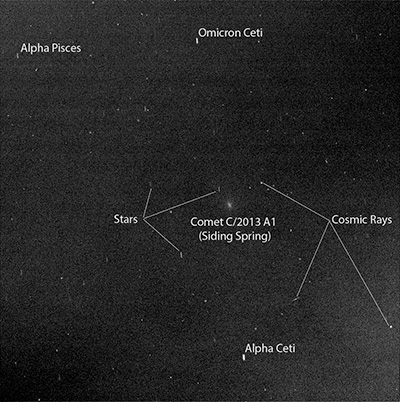 Above: Researchers used the Pancam on NASA's Mars Exploration Rover Opportunity to capture this view of comet C/2013 A1 Siding Spring as it flew near Mars on Oct. 19, 2014. (NASA/JPL/Cornell/ASU/TAMU) Images of comet A1 Siding Spring from the rover's panoramic camera (Pancam) are online at: Researchers used Opportunity's Pancam to image at a range of exposure times about two-and-one-half hours before the closest approach of the nucleus of comet Siding Spring to Mars. By the time of closest approach at about 87,000 miles (139,500 kilometers), dawn had lit the sky above Opportunity. "It's excitingly fortunate that this comet came so close to Mars to give us a chance to study it with the instruments we're using to study Mars," said Opportunity science team member Mark Lemmon of Texas A&M University, who coordinated the camera pointing. "The views from Mars rovers, in particular, give us a human perspective, because they are about as sensitive to light as our eyes would be." |
Robert Pearlman
Editor Posts: 42988
From: Houston, TX
Registered: Nov 1999
|
 posted 10-20-2014 06:59 PM
posted 10-20-2014 06:59 PM
   
University of Arizona HiRISE release Images of Comet C/2013 A1 Siding SpringOort Cloud comet Siding Spring made its closest pass to Mars and the Mars Reconnaissance Orbiter (MRO) on Sunday, 19 October 2014. The highest-resolution images were acquired by HiRISE at the minimum distance of 138,000 kilometers. The image has a scale of 138 meters per pixel. 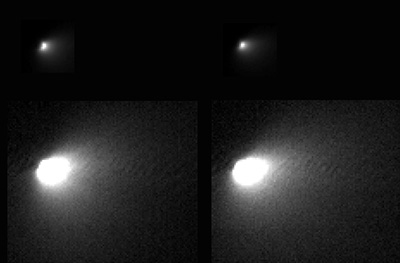 Telescopic observers modeled the size of the nucleus as about 1 kilometer wide. However, the best HiRISE images show only 2-3 pixels across the brightest feature, suggesting a size smaller than 0.5 kilometers for this nucleus, the first ever imaged for a long-period comet. This composite image shows two of the best HiRISE images of the comet. Shown at top are images with the full dynamic range, showing the nucleus and bright coma near the nucleus. Shown at bottom are versions where the fainter outer coma is brightened, saturating the inner region. These closest-approach images were made possible due to very precise pointing and slewing of the MRO spacecraft by engineers at Lockheed-Martin in Denver, based on comet position calculations by engineers at JPL. HiRISE acquired three images 12 days before closest approach, when the comet was barely detectable above the “noise level” of the images. These early images showed the comet was not quite at its predicted location! This new viewing angle on the comet was used to update its predicted location and timing at closest approach. Without this update, the comet may have been outside the HiRISE image area in the best images. |
Robert Pearlman
Editor Posts: 42988
From: Houston, TX
Registered: Nov 1999
|
 posted 10-23-2014 05:30 PM
posted 10-23-2014 05:30 PM
   
NASA release Close Encounters: Comet Siding Spring Seen Next to MarsThis composite NASA Hubble Space Telescope Image captures the positions of comet Siding Spring and Mars in a never-before-seen close passage of a comet by the Red Planet, which happened at 2:28 p.m. EDT October 19, 2014. The comet passed by Mars at approximately 87,000 miles (about one-third of the distance between Earth and the Moon). At that time, the comet and Mars were approximately 149 million miles from Earth. 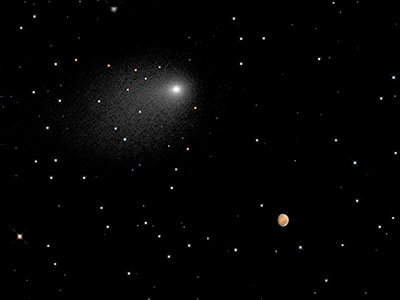 The comet image shown here is a composite of Hubble exposures taken between Oct. 18, 8:06 a.m. EDT to Oct. 19, 11:17 p.m. EDT. Hubble took a separate photograph of Mars at 10:37 p.m. EDT on Oct. 18. The Mars and comet images have been added together to create a single picture to illustrate the angular separation, or distance, between the comet and Mars at closest approach. The separation is approximately 1.5 arc minutes, or one-twentieth of the angular diameter of the full Moon. The background starfield in this composite image is synthesized from ground-based telescope data provided by the Palomar Digital Sky Survey, which has been reprocessed to approximate Hubble’s resolution. The solid icy comet nucleus is too small to be resolved in the Hubble picture. The comet’s bright coma, a diffuse cloud of dust enshrouding the nucleus, and a dusty tail, are clearly visible. This is a composite image because a single exposure of the stellar background, comet Siding Spring, and Mars would be problematic. Mars is actually 10,000 times brighter than the comet, and so could not be properly exposed to show detail in the Red Planet. The comet and Mars were also moving with respect to each other and so could not be imaged simultaneously in one exposure without one of the objects being motion blurred. Hubble had to be programmed to track on the comet and Mars separately in two different observations. The images were taken with Hubble’s Wide Field Camera 3. | |
Contact Us | The Source for Space History & Artifacts
Copyright 2020 collectSPACE.com All rights reserved.

Ultimate Bulletin Board 5.47a
|
|

|
 advertisement advertisement

|

















